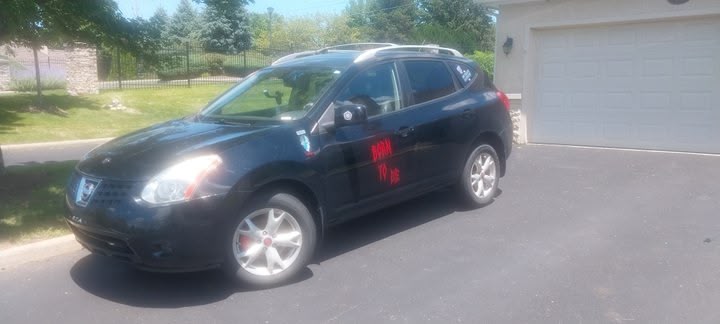BamPow · 51-55, M
I’ve started doing some research, because I’m going to be in the market for a new vehicle in a few months. What I’ve seen regarding CVT is that it’s less stressful on engines than a regular automatic and is a smoother driving experience, but the downside is that repairs are going to be more expensive when it goes. I don’t have any experience with it, so I’ll be interested if anyone responds who has one.
swirlie · 31-35
@BamPow
I do nautical marine tech research as part of my gig, so I've just started researching this CVT thing for cars & SUV's.
What I've found so far is that a CVT transmission requires the driver to learn how to drive all over again because what applied to an automatic transmission, does not apply to the operation of a CVT transmission. Subtle differences, but can be annoying differences just the same.
I found out that a car with a CVT cannot pull a trailer or any kind of heavy load in the vehicle because it was not designed to pull stuff, but only to carry light loads... such as 2 people in the car plus half a tank of gas.. and those are the actual specs!
There is also a 2 second delay from the time you step on the gas until the car starts moving which can be problematic for stop and go traffic following you!
Also, when going down a hill and you take your foot off the gas to coast, the CVT will immediately slow the car down to the equivalent of idle-speed with your foot off the gas, as if idling through a parking lot for example.
To go downhill, you must keep your foot pressed on the gas to maintain the speed you were going on level road surfaces, otherwise you'll start to slow down from the inherent engine braking effect, instead of coasting or slightly accelerating from downhill inertia like at automatic transmission can be expected to otherwise operate.
I do nautical marine tech research as part of my gig, so I've just started researching this CVT thing for cars & SUV's.
What I've found so far is that a CVT transmission requires the driver to learn how to drive all over again because what applied to an automatic transmission, does not apply to the operation of a CVT transmission. Subtle differences, but can be annoying differences just the same.
I found out that a car with a CVT cannot pull a trailer or any kind of heavy load in the vehicle because it was not designed to pull stuff, but only to carry light loads... such as 2 people in the car plus half a tank of gas.. and those are the actual specs!
There is also a 2 second delay from the time you step on the gas until the car starts moving which can be problematic for stop and go traffic following you!
Also, when going down a hill and you take your foot off the gas to coast, the CVT will immediately slow the car down to the equivalent of idle-speed with your foot off the gas, as if idling through a parking lot for example.
To go downhill, you must keep your foot pressed on the gas to maintain the speed you were going on level road surfaces, otherwise you'll start to slow down from the inherent engine braking effect, instead of coasting or slightly accelerating from downhill inertia like at automatic transmission can be expected to otherwise operate.
fortycreek · M
@swirlie interesting information I was not aware of this
swirlie · 31-35
@fortycreek
What I've deduced after researching CVT technology, is that a CVT transmission is redundant. It has no bonafide relevance in the real world of automobiles. It does not save a lot of gas unless the vehicle is predominately operated in city traffic, such as if the car was used a taxi cab doing stop and go driving all day.
But if you drive primarily at speeds above 40 mph in your average day, you will not save a penny in fuel using a CVT. This is because the CVT operates the engine RPM at the most efficient RPM at all times, thereby causing the CVT to make all the ground speed adjustments itself as you creep through traffic instead of the engine RPM making all the ground speed adjustments, therefore operating at very fuel-consuming low RPM's in the city if only an automatic transmission is installed, not a CVT.
Once you're out on the highway and the CVT maximizes it's highest speed ratio that it is capable of achieving, if you want to go faster, the CVT has no other option except to increase the engine RPM beyond it's maximum efficiency RPM to achieve that higher-desired ground speed.
I should point out that ALL car engines with an automatic transmission achieve the greatest fuel range at 42 mph. Whatever RPM achieves that ground speed is what a CVT operates it's engine at, at all times, while the CVT adjusts itself around that constant-RPM base, which is in the order of about 1800 RPM.
What I've deduced after researching CVT technology, is that a CVT transmission is redundant. It has no bonafide relevance in the real world of automobiles. It does not save a lot of gas unless the vehicle is predominately operated in city traffic, such as if the car was used a taxi cab doing stop and go driving all day.
But if you drive primarily at speeds above 40 mph in your average day, you will not save a penny in fuel using a CVT. This is because the CVT operates the engine RPM at the most efficient RPM at all times, thereby causing the CVT to make all the ground speed adjustments itself as you creep through traffic instead of the engine RPM making all the ground speed adjustments, therefore operating at very fuel-consuming low RPM's in the city if only an automatic transmission is installed, not a CVT.
Once you're out on the highway and the CVT maximizes it's highest speed ratio that it is capable of achieving, if you want to go faster, the CVT has no other option except to increase the engine RPM beyond it's maximum efficiency RPM to achieve that higher-desired ground speed.
I should point out that ALL car engines with an automatic transmission achieve the greatest fuel range at 42 mph. Whatever RPM achieves that ground speed is what a CVT operates it's engine at, at all times, while the CVT adjusts itself around that constant-RPM base, which is in the order of about 1800 RPM.
HoeBag · 46-50, F
From what I have read, CVT have more problems typically than automatics.
I know a lot of newer cars use them so they are hard to avoid.
If you are buying a car that is new or very low miles, it should last a while.
Usually it is when buying used with considerable mileage that one needs to think, "How much longer will this thing last anyways?"
I know a lot of newer cars use them so they are hard to avoid.
If you are buying a car that is new or very low miles, it should last a while.
Usually it is when buying used with considerable mileage that one needs to think, "How much longer will this thing last anyways?"
sarabee1995 · 26-30, F
Okay, so I've owned a hand-me-down Toyota Prius, and I've bought two cars so far in my adult life: a 2017-ish used Subaru Crosstrek (which my fiance now drives) and just bought a new 2025 Subaru Crosstrek.
All three cars have been CVT transmissions. My brother says CVTs are junk. Honestly, I love how smooth they drive. I've never had a problem and I drive a LOT.
All three cars have been CVT transmissions. My brother says CVTs are junk. Honestly, I love how smooth they drive. I've never had a problem and I drive a LOT.
swirlie · 31-35
@sarabee1995
Interesting what you say about Toyota Prius! I was just reading in my tech research that Toyota uses a non-standard version of CVT technology in the Prius, which is the installation of a 1st gear (mechanical) considering that CVT's don't actually have any gears at all. So this amounts to a one-gear + CVT technology.
What the most common problem with even modern CVT's is a 2 second lag-time that often exists from when you start out from a dead stop, where you hit the gas but nothing happens.. for 1 to 2 seconds except for the engine accelerating, but the car not moving. Suddenly the car will start to move and moves forward at the usual rate of acceleration.
In the Prius however, the car responds immediately to throttle movement by getting the car going in that 1st gear, but then the CVT technology takes over about 2 seconds after the car moves along in 1st gear mechanical, then transitions to CVT variable speed technology thereafter.
I don't know if the Crosstrek uses that Prius technology or not, but if it doesn't, then you might notice a slight lag or delay in forward motion when starting out from a stop.
Don't know why your brother thinks CVT's are junk, unless he's old school in his auto aspirations!
I think what annoys me the most about modern cars are the 8 and 10 speed transmissions they use now. I was test-driving a VW Atlas SUV and I was actually holding up traffic behind me because my car couldn't run through all the gears as fast as the cars behind me were accelerating from a stop light!
With CVT, I understand that the acceleration is more like one continuous acceleration line from zero to 60, which I think I'd prefer in a car. I ride a motorcycle, so this CVT research is new stuff for me! Thanks!
Interesting what you say about Toyota Prius! I was just reading in my tech research that Toyota uses a non-standard version of CVT technology in the Prius, which is the installation of a 1st gear (mechanical) considering that CVT's don't actually have any gears at all. So this amounts to a one-gear + CVT technology.
What the most common problem with even modern CVT's is a 2 second lag-time that often exists from when you start out from a dead stop, where you hit the gas but nothing happens.. for 1 to 2 seconds except for the engine accelerating, but the car not moving. Suddenly the car will start to move and moves forward at the usual rate of acceleration.
In the Prius however, the car responds immediately to throttle movement by getting the car going in that 1st gear, but then the CVT technology takes over about 2 seconds after the car moves along in 1st gear mechanical, then transitions to CVT variable speed technology thereafter.
I don't know if the Crosstrek uses that Prius technology or not, but if it doesn't, then you might notice a slight lag or delay in forward motion when starting out from a stop.
Don't know why your brother thinks CVT's are junk, unless he's old school in his auto aspirations!
I think what annoys me the most about modern cars are the 8 and 10 speed transmissions they use now. I was test-driving a VW Atlas SUV and I was actually holding up traffic behind me because my car couldn't run through all the gears as fast as the cars behind me were accelerating from a stop light!
With CVT, I understand that the acceleration is more like one continuous acceleration line from zero to 60, which I think I'd prefer in a car. I ride a motorcycle, so this CVT research is new stuff for me! Thanks!
sarabee1995 · 26-30, F
@swirlie Wow. All very interesting. I've never noticed any lag when starting out, but then I'm not one to want to scream off the line. I'm more chill in my driving. 🤷♀
HoeBag · 46-50, F
BTW here is a site I found that lists cars that do not have CVT. I do not know if you are trying to find or avoid CVT but here is a site that may help your search.
https://www.carcitywholesale.com/blogs/list-of-cars-without-cvts.htm
https://www.carcitywholesale.com/blogs/list-of-cars-without-cvts.htm
Most economy cars have a CVT transmission, Honda, Toyota, Hyundai, Kia, Chevrolet..
when they first came out twenty years ago they were very problematic but the technology has improved greatly.. as long as you don’t drive it like a performance sport car they are reliable enough to last well over a hundred thousand miles
when they first came out twenty years ago they were very problematic but the technology has improved greatly.. as long as you don’t drive it like a performance sport car they are reliable enough to last well over a hundred thousand miles
swirlie · 31-35
@Telcontar
The Subaru Justy ..apparently had it in 1989 I was reading, but then the other makes and models you mentioned had CVT only as an option during the 1990's but it wasn't widely embraced by automotive enthusiasts. This is probably why most of those economy cars you mentioned didn't have CVT as the preferred transmission option for North American imports.
I ride a motorcycle and always have, but the issue of CVT came up the other day among my female colleagues and I thought CVT was relatively new in North America since I'd never heard of it, but it now appears to be standard on those imported models you mentioned.
The Subaru Justy ..apparently had it in 1989 I was reading, but then the other makes and models you mentioned had CVT only as an option during the 1990's but it wasn't widely embraced by automotive enthusiasts. This is probably why most of those economy cars you mentioned didn't have CVT as the preferred transmission option for North American imports.
I ride a motorcycle and always have, but the issue of CVT came up the other day among my female colleagues and I thought CVT was relatively new in North America since I'd never heard of it, but it now appears to be standard on those imported models you mentioned.
LILREBELDOM69VAMP69 · 46-50, M
jasonfire · 56-60, M
no they always have to complicate things!











